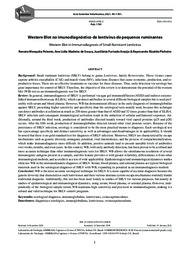Western Blot no imunodiagnóstico de lentivírus de pequenos ruminantes.
Western Blot no imunodiagnóstico de lentivírus de pequenos ruminantes.
Author(s): PEIXOTO, R. M.; SOUSA, A. L. M. de; ARAÚJO, J. F.; PINHEIRO, R. R.
Summary: Background: Small ruminant lentivirus (SRLV) belong to genus Lentivirus, family Retroviridae. These viruses cause caprine arthritis encephalitis (CAE) and maedi visna (MV), infectious diseases that cause economic, production, and reproductive losses. There are no effective treatments or vaccines for these diseases. Thus, early detection via serology has great importance for control of SRLV. Therefore, the objective of this review is to demonstrate the potential of the western blot (WB) test as an immunodiagnostic test for SRLV. Review: In general, immunodiagnosis of SRLV is performed via agar gel immunodiffusion (AGID) and indirect enzyme linked immunosorbent assay (ELISA), which can detect antibodies in several different biological samples but is used pref- erably with serum and blood plasma. However, WB has demonstrated efficacy in the early diagnosis of immunoglobulins against SRLV, presenting higher sensitivity and specificity than the serological tests usually used, because this technique can detect antibodies at a dilution as much as 256 times greater than that of AGID and 32 times greater than that of ELISA. SRLV infection and consequent immunological activation result in the induction of cellular and humoral responses. Ad-ditionally, around the third week, production of antibodies directed mainly toward viral capsid proteins (p25 and p28) occurs. After the fifth week, production of immunoglobulins directed toward other viral proteins occurs. Because of the persistence of SRLV infection, serology is considered to be the most practical means to diagnosis. Each serological test has a percentage specificity and distinct sensitivity, as well as advantages and disadvantages in its applicability. It should be noted that there is no gold standard test for diagnosis of SRLV infection. Moreover, SRLV are characterized by escape mechanisms such as genetic diversity, mutagenic potential, viral intermittence, and the process of compartmentalization, which make immunodiagnosis more difficult. In addition, positive animals tend to present unstable levels of antibodies over weeks, months, and even years. In this context, WB, with early antibody detection, has been proven to be a refined and more accurate technique than other immunodiagnostic tests for SRLV. WB allows the simultaneous resolution of several immunogenic antigens present in a sample, and this feature provides it with greater reliability, differentiates it from other immunological methods, and accredits it as a test of wide applicability. Epidemiological and immunological dynamics studies often use WB in the immunodynamic diagnosis of SRLV. Serum, blood plasma, and seminal plasma are typical biological materials used in the serological diagnosis of SRLV with WB, expanding its potential as an immunodiagnosis method. Conclusion: WB is the most accurate serological technique for SRLV. It is more capable of accurate diagnosis because the genetic diversity that characterizes such lentiviruses and their various immune system escape mechanisms routinely hinder traditional diagnosis. Additionally, this test has been used widely in studies of SRLV for various purposes, but mainly in studies of epidemiological and immunological dynamics, using serum, blood plasma, or seminal plasma. However, independently of the biological sample tested, WB maintains high sensitivity and precision in immunodiagnosis, making it a refined and valid technique for SRLV control programs.
Publication year: 2021
Types of publication: Journal article
Unit: Embrapa Goats & Sheep
Observation
Some of Embrapa's publications are published as ePub files. To read them, use or download one of the following free software options to your computer or mobile device. Android: Google Play Books; IOS: iBooks; Windows and Linux: Calibre.
Access other publications
Access the Agricultural Research Database (BDPA) to consult Embrapa's full library collection and records.
Visit Embrapa Bookstore to purchase books and other publications sold by Embrapa.

